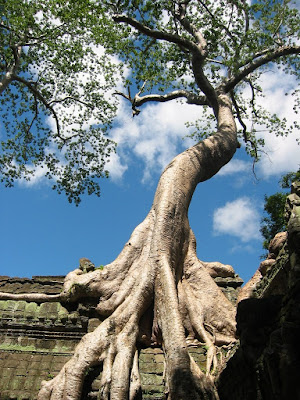 A visitor walks past the alleged Khmer Rouge list of rules at the prison that became known as the Tuol Sleng genocide museum in Phnom Penh. Tang Chhin Sothy / AFP
A visitor walks past the alleged Khmer Rouge list of rules at the prison that became known as the Tuol Sleng genocide museum in Phnom Penh. Tang Chhin Sothy / AFPCashing in on the killing fields
April 28. 2009
Jared Ferrie, Foreign Correspondent
The National (United Arab Emirates)
ANLONG VENG, CAMBODIA - As his former boss faces war crimes charges for running a Khmer Rouge torture centre, the prison’s chief photographer plans to capitalise on his country’s dark legacy.
Nhem En hopes to raise at least US$500,000 (Dh1.8million) by selling two cameras he used to photograph many of the estimated 17,000 prisoners before they were tortured and executed.
“All Khmer Rouge leaders and prisoners at S21 were photographed with these cameras, so the buyers can take them to exhibits around the world,” said Mr Nhem, who said he had “met everyone” in the Khmer Rouge leadership while taking their portraits.
Mr Nhem said he has other items, including the alleged footwear of the regime’s leader, Pol Pot, which he also plans to auction off.
He said he would use the profits to build a museum in Anlong Veng, the former Khmer Rouge stronghold where he is now district vice governor. Many of the regime’s former figures hold positions of power in the area, which fell to the government in April 1998, ending two decades of civil war.
Mr Nhem is banking on curiosity about the regime that plunged Cambodia into “year zero” in an attempt to create an agrarian utopia by executing intellectuals and eradicating traditional family structures, among other disastrous policies.
Two similar museums in the capital, Phnom Penh, are popular with tourists. One of them is the former S21 prison, where many of Mr Nhem’s chilling black and white images are displayed, the prisoners staring wide-eyed with terror into the camera.
The most significant site in Anlong Veng is the grave of Pol Pot, who died, reportedly of a heart attack, as government forces were closing in. His remains were hurriedly cremated and they now lie buried beneath a rusting sheet of corrugated metal.
Although he is widely reviled as the mastermind of a movement that killed as many as two million Cambodians, his final resting place regularly receives visitors who sometimes leave offerings and pray.
One of them, Phan Phary, laid a bunch of bananas at the grave and lit a few sticks of incense before making a short prayer.
“I know Pol Pot killed a lot of people and he was a bad man, but he was the leader here and people living here respect him,” she said. “They need to respect him to bring luck and happiness for their families.”
Him Chhay, who lives in a small wooden house adjacent to the site, said Pol Pot was cruel during the Khmer Rouge’s reign from 1975 to 1979, but by the time he took refuge in Anlong Veng as an ageing guerrilla fighter he had softened.
“It’s better to have a big museum for Pol Pot’s grave because at least he is a former leader of Cambodia,” he added.
Youk Chhang, who heads the Documentation Centre of Cambodia, which researches Khmer Rouge history, said it was not surprising that residents retain a conflicted affinity for Pol Pot.
He explained most were members of the Khmer Rouge who took refuge in the area, which was jungle at the time, where they continued to fight against the government.
“Pol Pot was the only person who took care of them, who gave them food to eat,” Mr Chhang said. “He’s a father, he’s an uncle. But he was the architect of the genocide of Cambodia.”
Mr Chhang said the brutal legacy of the Khmer Rouge has had a psychological effect on many who fought with the movement and have not yet been reintegrated into Cambodian society.
“They are in search of an identity. They are in search of themselves,” he said.
Mention of the UN-backed war crimes tribunal, which recently began trying the first of five former leaders of the regime, prompted ambivalent responses from some residents.
“I don’t listen to the radio; I don’t care about this. I’m very busy with no time to think about it,” said Chan Lay, a former Khmer Rouge fighter who lost his leg during the war and uses a prosthetic limb.
Another resident, Khieu Dum, said the tribunal “is no use for Cambodian people”. He is the son of Khieu Samphan, one of the regime’s top leaders, who is in prison awaiting trial.
“My father is innocent,” Mr Khieu said in an interview at the busy gas station he owns in the centre of town.
Mr Chhang, of the Documentation Centre, said he supports the idea of creating a museum in Anlong Veng because it would help people in the area understand and come to terms with their history. He was, however, sceptical of how Mr Nhem acquired the items, and he suggested the sandals in particular might be impossible to verify as authentic.
Mr Nhem insisted the items were real. He said he was given the cameras in 1976 to work as an official photographer at S21, the prison run by Kaing Guek Eav, who is now on trial and has confessed to ordering torture and executions.
As for his own role in the regime, Mr Nhem was unapologetic.
He said he realised later that the party’s leadership, known as Angkor, led the country into disaster. But he photographed the prisoners at S21 because it was his job and he was fully committed to the party.
“My life was for Angkar, so everything I did was to obey Angkar’s orders,” Mr Nhem said. “You can judge me as guilty or innocent.”






















